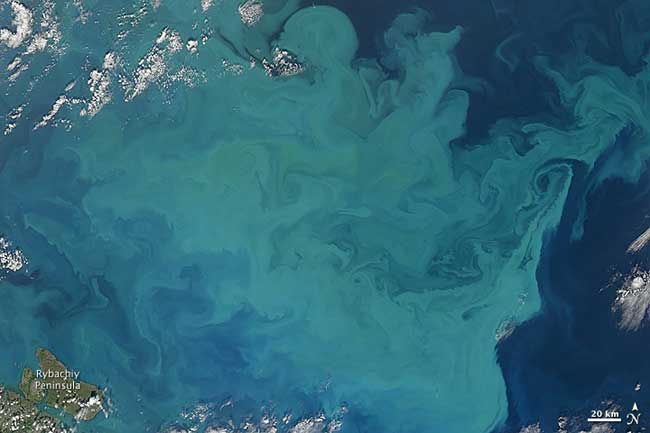Summer Bloom in the Barents Sea

In the chilly waters of the Barents Sea in mid-August, the ocean switched on its carbon dioxide vacuum as it often does, creating a giant bloom of single-celled, plant-like organisms called phytoplankton.
The bloom is off the northwestern corner of Russia. The image was captured by the Moderate Resolution Imaging Spectroradiometer (MODIS) on NASA's Aqua satellite on Aug. 19.
One important end-result of such blooms is to take carbon dioxide out of the atmosphere and, with a little help from fish poo, sequester it to the seafloor where it ends up, in millions of years, becoming an ingredient in rocks.
Here's how it works:
During these blooms, which can cover thousands of square miles of the ocean surface, a liter of seawater (about 4 cups) may contain a billion or more phytoplankton cells, according to NASA. Each cell is a microscopic chemical factory that vacuums carbon dioxide out of the surrounding seawater and uses photosynthesis to turn it into stored chemical energy.
The milky-blue color that dominates the bloom suggests that it contains large numbers of coccolithophores, phytoplankton that armor themselves with tiny calcium carbonate (chalk) scales. Chlorophyll and other light-harvesting pigments from other species of phytoplankton can add darker blues, greens, and reddish-browns to the bloom.
All phytoplankton are important to the ocean food web and to the global carbon cycle; as they use up the carbon dioxide dissolved in the water, more carbon dioxide from the atmosphere dissolves into the ocean. In the end, the organisms die or are eaten, and the carbon they withdrew from the atmosphere winds up on the floor of the ocean, NASA explained in a statement.
Sign up for the Live Science daily newsletter now
Get the world’s most fascinating discoveries delivered straight to your inbox.
Coccolithophores are especially significant in the carbon cycle, because they not only sequester carbon through photosynthesis, but also through their calcium carbonate scales, called coccoliths.
When a predator eats a coccolithophore, the scales are not usually digested, and they become concentrated in the predator¹s fecal pellets, or what the rest of us might call fish poo. The pellets are heavier than free-floating scales, so they sink more quickly to the seafloor, providing an additional way for atmospheric carbon dioxide to get stored in the deep ocean.
Over millions of years, the coccoliths build up into layers of calcium-rich sediment than can be tens to thousands of meters thick. The sediment eventually gets compressed into rocks such as limestone.
- Top 10 Craziest Environmental Ideas
- Top 10 Surprising Results of Global Warming
- The Science of Climate Change










